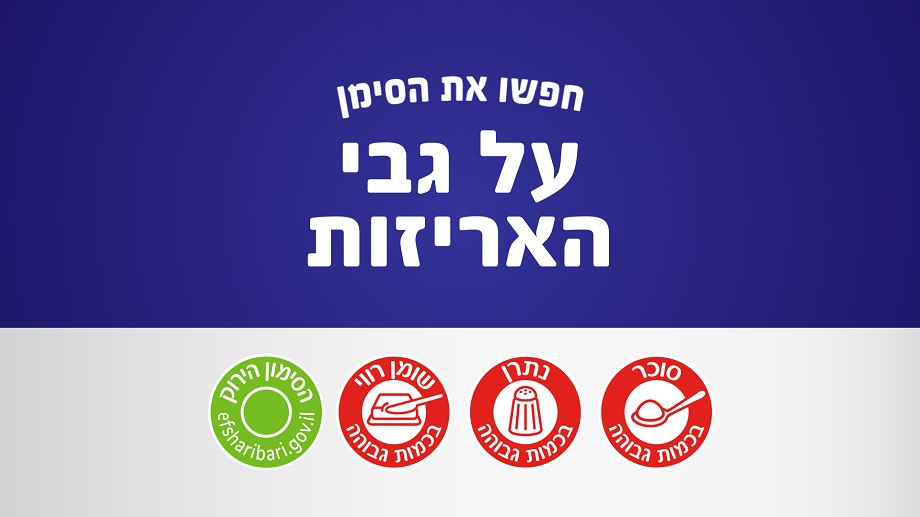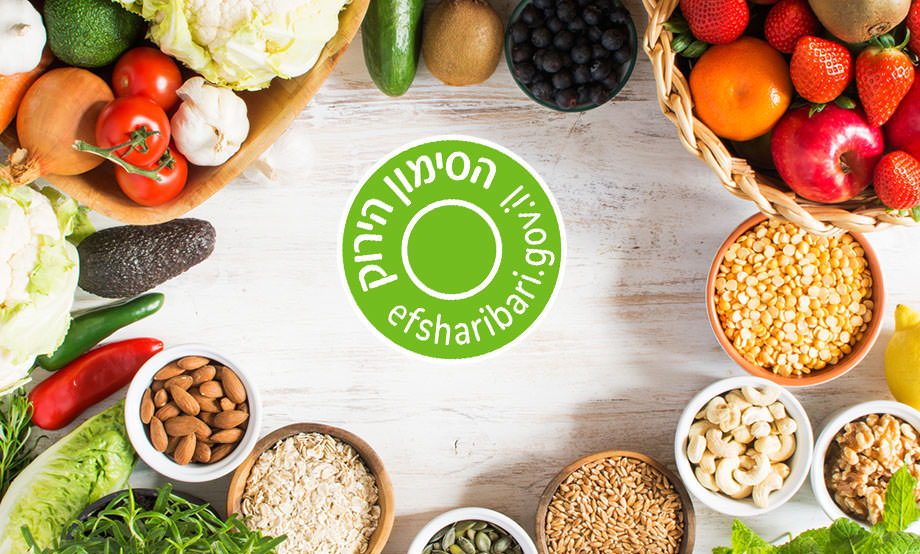
What is the green symbol for?
The green symbol is intended to help us as consumers make simpler and clearer healthy choices. The green symbol is not mandatory, but the Ministry of Health recommends farmers, food manufacturers and retailers to use it at points of sale, provided the food meets the conditions set by the special scientific committee appointed by the Ministry of Health.
What are the criteria for receiving a green symbol?
Foods and products eligible for the green symbol must meet the requirements of the Ministry of Health's nutrition recommendations. The key principles that guided the requirements for labeling are that foods would be based on minimal processing and avoiding the addition of harmful substances such as excess saturated fat, sugar and salt. By law, food that has a red symbol cannot receive a green symbol.
The foods and products that have a green symbol belong to the following food groups: milk, yogurt, cheese, tofu, soy drinks, certain vegetable oils, seeds and nuts, grains, legumes, raw tahini, tahini salad, fish, eggs, poultry, fruit and vegetables.
What are the differences between the red symbols and the green symbol?
Manufacturers are required by law to label packaged food products red if the quantities of sugar, saturated fat or sodium (the major component of table salt) in the food products is higher that the limit set by the Ministry of Health. They are designed to increase transparency and let consumers avoid consuming foods containing such substances – even those that are branded and marketed as “health products”.
In contrast, the green symbol is optional and it is not required to have it on packages, but manufacturers who have the symbol on packaged products can enjoy quick identification by potential customers as foods that comply with the Ministry of Health's nutrition recommendations.

Seek the symbols on packages (from right to left): high levels of sugar; high levels of sodium; high levels of saturated fat; the green symbol
What about products with no symbol?
Products without one of the three red symbols (high levels of sodium, sugar or saturated fats) have lower quantities of such substances than the upper limit levels set for labeling foods red.
These products are not defined as harmful foods, but are not necessarily recommended for consumption as part of a healthy diet. Often these foods are manufactured at the maximum processing level (ultra-processed), i.e. foods containing additives (such as nitrates, various preservatives, food coloring and other additives used in the industry and not in the domestic kitchen).
The green symbol is intended to make foods included in the Ministry of Health's nutrition recommendations stand out, and enable their clear and quick identification on the shelves of retailers and direct marketers.
Which products will receive a green symbol?
For the full detailed list on the Ministry of Health website (Hebrew)
- Dairy products: drinking milk, fermented milk products (buttermilk, yogurt, etc.) up to 5% fat, cheeses up to 5% with no additives except seasoning and salt up to 300 mg sodium per 100 g.
- Legume-based products: tofu with no additives (except seasoning and salt up to 300 mg sodium per 100 g), legume-based drinks with no additives (except salt up to 50 mg per 100 g).
- Vegetable oils: olive oil, avocado oil, almond oil, canola oil (rapeseed), safflower oil.
- Seeds, nuts, peanuts, and almonds: raw or roasted without additives.
- Grains that contain the whole grain in all forms of preparation: except frying, crackers or rice crackers (with no additives except seasoning and salt up to 300 mg sodium per 100 g). Whole grain flour, whole pasta – with no additives.
- Bread: 100% whole grain, up to 12% gluten out of the flour content, enzymes and oils as specified in the full guidelines, grains and seeds, vinegar and ascorbic acid, up to 400 mg sodium per 100 g).
- Legumes: whole kernels including broken and peeled legumes, in any form of preparation or packaging except frying. With no additives except seasoning and salt up to 300 mg sodium in 100 g.) Legume flours (100%) without additives, and legume spreads with seasoning, tahini, olive oil or lemon and salt (up to 300 mg sodium per 100 g).
- Tahini: raw tahini without toppings, ready-made tahini salad with no additives and salt (up to 300 mg sodium in 100 g).
- Fish: fresh, frozen, raw or prepared fish without additives. Baked / roasted / seasoned fish with no additives except seasoning and salt (up to 300 mg sodium in 100 g), canned fish (no additives, except seasoning, salt (up to 300 mg sodium in 100 g), water, approved vegetable oils).
- Eggs: fresh (in the shell).
- Chicken, turkey etc.: fresh, chilled or frozen (raw), whole or cut (excluding internal parts), baked or roasted (without additives except spices and salt up to 300 mg of sodium in 100 g).
- Fruit, vegetables, edible mushrooms and seaweed: In their raw form, in any preparation method or packaging except fried (addition of seasoning and salt - up to 300 mg per 100 g only). This does not include dried fruit (except dried dates and freeze-dried and reconstituted before eating). Excludes jams, powders, confitures, date honey and juices.

Printable green labeling poster in Hebrew and Arabic
The District Health Office – Jerusalem District, has produced and designed a unique poster that features the green symbol and explains it in simple terms, in order to help consumers make healthier choices. The poster can be circulated in various settings such as: Tipat Halav clinics, HMOs, hospitals, workplaces, the education system, food retailers and more.
Green symbol poster – Hebrew
Green symbol poster – Arabic
Important to know
- The recommendations for labeling with the green symbol are in addition to the requirements of the food legislation regarding labeling and do not detract from them.
- This is not a substitute for nutritional and/or medical recommendations for consumers with health or special nutritional needs.
- The recommendation for eating foods with green symbols are subject to the recommended amounts of consumption of different food categories, the variety of foods in each food category and the nutritional needs of each person according to the nutritional recommendations, and it does not stand alone.
- The green symbol reflects the Ministry of Health's recommendations solely in the nutritional aspect, as opposed to aspects of food safety or food quality.
- The process of determining recommendations for green labeling is gradual; a structured and transparent procedure for updating it will be established.
Recommendations for green labeling of food - the Ministry of Health’s Department of Nutrition Website (in Hebrew)
How to tag food with the Green Symbol
Regulations of Protection of Public Health, Nutritional Labeling (full format), 2017 (in Hebrew)
Food labeling and nutritional labeling
New dietary guidelines (in Hebrew)
Detailed guidelines on the use of the green symbol for bulk vegetables (in Hebrew)



